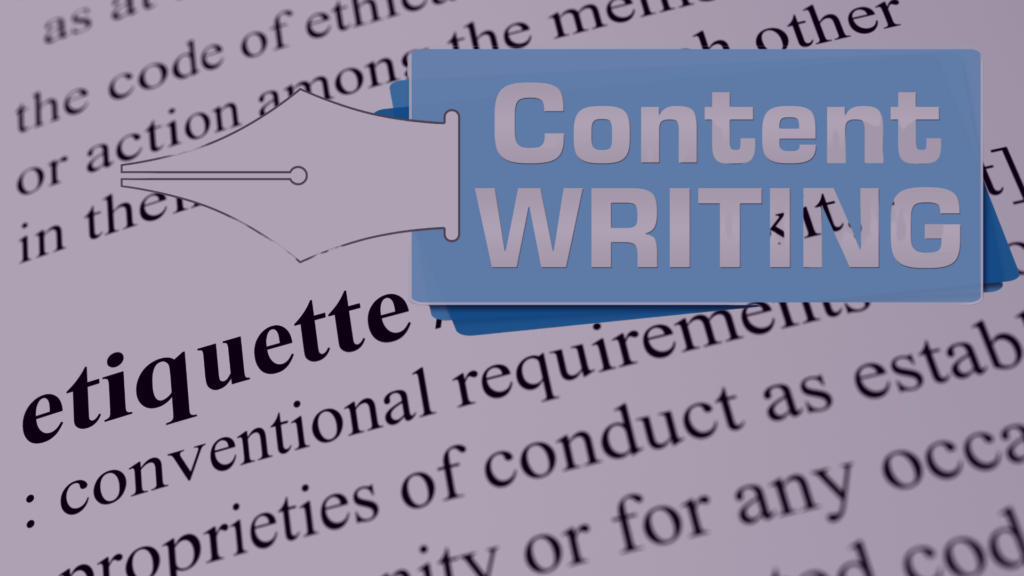Content Writing Etiquette 101
Content writing etiquette refers to the accepted principles, practices and norms adopted by content creators in the production, presentation and publication of written material for traditional and digital media. The written material ranges from articles, blog posts and product descriptions to social media posts, newsletters and white papers, which should be informative, engaging and valuable for the intended audience. In short, these are the dos and don’ts of content writing that ensure content writers create content that contributes to positive reader experiences.
Without content writing etiquette in place, it’s easy to make the Internet a free-for-all space where fake news, inappropriate content, and disruptive behavior (e.g., trolling and bullying) can thrive unchecked. With content writing etiquette, we can contribute towards creating, maintaining and fostering a respectful and responsible online environment while also decreasing the negative impact brought by misinformation, disrespectful interactions, and offensive content.
With that said, here are 10 dos and don’ts of content writing that every content writer must know and, in the case of readers, should demand from their favorite content providers, whether news sites or bloggers.
Words Have Power: Choose Your Language Wisely

Language is a powerful enough to influence thoughts, convey emotions, and shape perceptions! For this reason, the way we communicate our message can have a profound impact on readers, a power that should be wielded responsibly. Language and the words we use play pivotal roles, too, in the way that our message will be received by readers – and it’s true whether you’re writing step-by-step product assembly instructions or a thought-provoking essay on social justice.
Think of the Words’ Impact on Readers
Words can spark joy and sorrow, anger and compassion, and indifference and curiosity – the range of human emotions and reactions can be triggered and fueled by words, spoken deliberately or carelessly. Your choice in words must then be considered based on your desired impact on your readers, perhaps the decisions and actions you want them to make.
Do you want them to take positive action on your products and services? Does your message empower them to take control of their lives by changing their self-talk and self-perception? Do you want your readers to put their trust in your authority and expertise?
Whatever your message, you must choose words that make your content more engaging, compelling and memorable. In doing so, you’re encouraging them to come back for more of your content.
Avoid Insensitive and Offensive Language
Your readers deserve respect because, as cliche as it sounds, respect begets respect. Your content must then be free of insensitive and offensive language since an inclusive, positive and persuasive environment brings more results. Be conscious about the possible meanings behind words, as well as the prejudiced, derogatory and hurtful impact these can have on your target audience.
Use Inclusive Language
Even when you’re writing for a niche, being aware of inclusivity in your content is a must! Inclusive language shows respect for the diversity among your readers that, in turn, shows respect for their life choices. Gender, racial and lifestyle biases are a no-no in content writing, meaning the use of gender-neutral terms should be considered.
Other tips in content writing that acknowledge the power of words are avoiding repetitions and minimizing the use of filler words. Go for varied sentence structures and synonyms and more evocative words (i.e., the use of “very” can be annoying).
Originality Matters: Cite Your Sources and Prevent Plagiarism

Originality ranks high in the dos and don’ts of content writing because it’s the fundamental principle underlying the creation of credible, compelling and valuable content! Original content contributes to your reputation as a credible and trustworthy source of information, provides you with a distinctive viewpoint and voice, and generates more engagement with your readers!
But there are challenges to originality in the digital age, too, because of the unprecedented access to a wide range of information. Content writing etiquette demands creating original, trustworthy and compelling content while also acknowledging the works of others that contributed to your work.
This is where the following tips on maintaining originality while respecting intellectual property rights come in.
Understand Plagiarism
Plagiarism means using another person’s content without proper credit, citation and attribution that, in the process, also implying that they are your own. In this case, content means text (i.e., words, ideas and messages), images (e.g., photos, sketches, and paintings), and videos (e.g., shorts and vlogs), among other forms. Plagiarism carries serious consequences depending on its context, such as academic warning, suspension or expulsion in academia, loss of reputation and termination of employment in industries, and copyright infringement lawsuits.
Avoid Plagiarism
Yes, it’s easier to use the copy-and-paste function and cross your fingers nobody calls you on it, but with the Internet being what it is, you will be called out, sooner or later. You can, fortunately, prevent plagiarism from being one of your notorious breaches of content writing etiquette by following these tips.
- Always cite your sources, both in your direct quotes and paraphrased content. You can choose the best citation style for your content and its content – examples include Chicago, APA and MLA. Be sure to attribute concepts, ideas and even data considered as common knowledge to their original sources.
- Use quotation marks and cite your sources when you’re making direct quotations from another author’s work. Even short sentences and phrases directly culled from someone’s work must be used in quotations for proper credit.
- Paraphrase content in a way that it becomes yours. Don’t change a few words here and there while keeping the same sentence structure because it can still be considered plagiarism. Don’t use spinning software either – not only will it put your content at risk of plagiarism but it will read more like an AI-generated content and less like human-centric content.
- Credit all types of media, too, including images, videos, and audio clips that you use in your content.
- Ask for permission from the rightful owners of copyrighted material and put it into writing. Even with permission, be sure cite your sources as a gesture of giving credit where it is due.
- Use plagiarism detection tools that can identify potential issues in your content before submitting, posting or publishing your content.
Most importantly, you must create your own original insights, interpretations and analysis that will showcase your own understanding of the subject and add value to your content. Even when you’re reusing your own content for submission to different platforms or publications, you must also use proper citations (i.e., self-plagiarism).
Respect Intellectual Copyright: Proper Use of Images and References

We want to dive deeper into intellectual copyright because it’s not just among the fundamentals of writing etiquettes for a content writer but, more importantly, it can result in expensive lawsuits!
The copyright laws in the U.S. grant creators and producers the exclusive authority over their original works in their reproduction, distribution, public performances or displays, derivative works, and digital storage and transmission. In short, content creators have the sole legal right to decide who can use their content, how it can be used, and under what conditions (e.g., time, place and duration).
Fair use is related to copyright laws, but it has a more limited application. As a legal doctrine, it allows other people the limited use of copyrighted material in their own content even without permission from the copyright holder. By limited use, it means for commentary and criticism, education and research, and news reporting.
As previously mentioned, it’s crucial for content writers to credit their sources properly through permission, attribution and citation. If you’re using Creative Commons images, for example, you must seek express and written permission from the copyright holder and follow the platform’s attribution rules – unless, of course, your use falls under the fair use category.
If in doubt, you may want to ask a copyright lawyer or seek more information.
Tone and Voice: Customize Your Content to Your Audience

The ability to master the tone and voice of your content is at the heart of effective connection and engagement with your target audience. Along with the words you choose, the manner in which you convey your message plays a significant role in your target audience’s perception of your content.
Define Your Content’s Tone and Voice
The first steps are knowing what tone and voice are followed by defining your content’s tone and voice. While tone and voice are used interchangeably, they have different meanings.
On one hand, tone refers to the emotion, attitude and style in which content is written and presented to its audience. Your tone can be formal or informal, friendly or authoritative, informative or persuasive, or any combination of these. You want a tone that aligns with your audience’s preferences as well as the purpose of your content.
On the other hand, voice refers to your unique personality and perspective as a content writer. Think of it as your distinct way of using language in expressing ideas and conveying emotions, a uniqueness that distinguishes your content from other authors also discussing the same topic. Your voice contributes to your brand, your identity and your signature style as a content writer
Once you have identified and developed your tone and voice for your content, you will find it easier to follow the next steps.
Adapt Your Tone for Different Platforms
Effective communication, connection and engagement with your target audience happens on different platforms, meaning there should be a change in your tone based on the platform. For example, LinkedIn content should have a professional tone while Instagram content has a more casual tone with more visual engagement required. You must understand the nuances in each of these platforms so that you can change your content’s tone accordingly.
Maintain Consistency of Voice Across Platforms
But while you must change your tone based on the platform, you should maintain a consistent voice across platforms! Aside from the obvious brand-associated images, your audience should recognize your original content even when it’s outside of your official website.
The reason: Consistency of voice contributes to familiarity and trust among your audience. But, keep in mind, too, that consistency doesn’t mean monotonous, rehashed and reused content.
No matter your tone and voice in your content, the etiquette of content writing includes being sensitive to the cultural differences in our interconnected society, more so on the Internet where everything can be recorded, saved and made a screenshot.
Inclusivity and Diversity: Embrace Different Perspectives

The ability to recognize and celebrate diversity is a must-have courtesy in our intercultural world! We’re not just talking about the physical realm but in the content we create for, consume in and share with on traditional and digital media. By embracing diverse perspectives when writing content, we promote a more accepting, open and inclusive society.
Recognize the Value of Inclusivity and Diversity
The first step in this regard is to write with inclusivity and diversity in mind – while you’re writing for a specific audience, you have a diverse audience, too. When you incorporate the experiences, perspectives and opinions of different individuals, you can create a more relatable and realistic content that allows your target audience to connect and engage.
Avoid Stereotypes and Assumptions
The diversity of human experiences means that stereotypes and assumptions should have no place in the minds of the best content writers! Stereotypes are oversimplified, usually inaccurate, assumptions about particular individuals and groups of people that can limit the depth, breadth and genuineness of your content. Plus, stereotypes can perpetuate harmful biases including sexism, misogyny and racism.
Instead of using stereotypes and assumptions, you should create complex characters and narratives reflecting the diversity of the human experience. You can start by researching reliable sources of information, interacting with individuals from different backgrounds, and opening yourself to new perspectives and experiences.
In doing so, you have reliable information that can be used to represent diverse views in your content! Your authentic representation of the experiences and emotions, trials and triumphs, and perspectives of individuals will add meaning and value to your content.
Stick to the Facts: Build and Strengthen Trust through Reliable and Informative Content

Of the writing etiquettes for a content writer, factual accuracy ranks high, too, because of its crucial role in building and reinforcing trust, reliability and credibility among your target audience! Here, we will look at the significance of sticking to the facts and the steps in presenting data, addressing misinformation and correcting errors.
Why Factual Accuracy Is a Must
Inaccurate information, more often than not, creates misinformation and misunderstandings as well as a general erosion of trust, integrity and credibility for content writers. In contrast, fact-based information with real and reliable sources builds trust among your audience for your content – and an audience that trusts your content will likely return for more engagement with the assurance that your content provides factual information.
What to Do in Getting and Sticking to the Facts
As a content creator, you have the right and responsibility to verify the information for your content and to ensure that it comes from trustworthy sources. When it comes to trustworthiness, academic institutions, peer-reviewed journals and reputable news outlets as well as authoritative experts are among the best sources.
But don’t rely on a single source either regardless if it’s a trustworthy one! Be sure to cross-reference information from several trusted resources before submission or publication of your content.
Transparency, completeness and honesty are a must when it comes to the presentation of data and statistics. You should avoid cherry-picking data since it can be misleading. Instead, you must provide the appropriate context to the data presented and present a balanced perspective of the conclusion derived from its analysis.
By presenting charts, graphs and other visual aids in a clear and objective manner, your audience can make their own suitable interpretations. This is also part of respecting your audience and adopting writing etiquettes for a content writer.
Of course, mistakes can be made – we are but humans – but being human doesn’t excuse content writers from making amends! When errors are identified, you must address them in a prompt and proper manner – with honesty and transparency, to be exact. Be sure to clearly state the content’s errors and the corrections made, a crucial step in demonstrating your accountability and commitment to facts.
Engagement and Responsiveness: Meaningful Interactions with Your Readers
Among the unwritten rules of content writing is getting your target audience’s attention, encouraging them to engage with your content, and getting positive responses. Such meaningful interactions promote your online presence, strengthen trust in your content, and enhance a sense of community among your readers!
Of greater importance in meaningful interactions is their humanizing effect on your brand – or online persona, if you will – that makes it more approachable and relatable. While artificial intelligence (AI) has its appeal, your readers are humans and, thus, appealing to humans and their human experiences is of paramount importance in content writing.
Respond in a Positive Manner
Your content must then encourage readers to engage, whether it’s to respond to questions, to leave comments, or to give feedback. You must show your appreciation for the time and effort that your readers spent on engaging with your content, whether it’s positive or negative. You may want to respond in a snarky manner but remember that content writing etiquette means being genuine, courteous and professional, as well as giving personalized comments whenever necessary.
Handle Criticisms Well
When comments become below-the-belt criticisms, when trolls become bullies, and when boundaries are crossed, you must keep your wits! Respond to negative comments in a professional manner, you’re demonstrating your openness for dialogue. Keep in mind, too, that constructive criticism is an opportunity for personal growth instead of taking it on a personal level.
But it’s also crucial to establish boundaries! You can set the topics, words and actions that are acceptable, as well as the actions you can take to maintain civility in your content (e.g., blocking aggressive readers).
Collaborations: Convergence of Content

While content writing may seem like a solitary activity, it isn’t! Collaborations with other content creators are among the unwritten rules of content writing, and these result in meaningful and powerful convergence of content. Your colleagues, peers and editors can offer fresh insights, ideas and perspectives that you may have overlooked or haven’t considered.
Openness of Mind and Willingness to Listen
Of the traits that make collaborations effective, the crucial ones are an open mind and ears! You must recognize that feedback, inputs and even criticism from others are opportunities for content improvement, not a critique per se of your content writing abilities.
Balance Your Internal Vision with External Feedback
By being receptive to diverse viewpoints, your content will also show diversity and inclusivity while still highlighting your unique voice. But we know that it’s a challenge to stay true to your vision while acknowledging the validity of external input. We suggest looking at collaboration as enhancing your content, not sacrificing its overall direction and specific ideas.
Here are tips that you can remember for productive collaborations on content creation.
- Evaluate the suggestions and choose the ones that align with your content’s core purpose or message.
- Maintain a positive attitude when receiving revisions including edits and inputs from others. The willingness to accept edits isn’t a manifestation of your sense of inferiority – it’s testament to your commitment to creating valuable content.
- Communicate your thoughts, concerns and expectations clearly.
- Be flexible and adaptable in your attitude, too.
- Express your appreciation and gratitude for the collaboration.
Learning something new, meeting new people and experiencing new things are the fruits of many collaborations – and that’s what will make your content writing better, too.
Ethics of Content: Balance Content and Commercial Interests

The ethics and etiquette of content creation are closely related. Where ethics include the principles of right and wrong behavior, etiquette includes accepted norms usually based on ethics. Such a close relationship manifests itself when commercial interests come into the picture of content writing.
Again, it’s a challenge to balance valuable content and commercial interests, but you will agree that valuable content feeds commercial interests! When you provide valuable content, you can reap positive outcomes including building trust and authority, increasing audience engagement, and improving your organic traffic and search engine visibility.
Here are tips to remember in balancing content with commercial interests during content writing.
Make Disclosures About Sponsored Content and Affiliations
If you’re benefiting from promoting products and services on your content, you must disclose your connections with these commodities and their companies. Your readers can then make informed decisions based on your disclosure. This is also true when making clear distinctions between your personal opinions and professional endorsements.
Prioritize Your Readers’ Needs
Your readers should be your first priority and, in doing so, you can deliver genuine, relatable and valuable content. Your audience will likely make positive associations between your values as a brand and your commercial interests, such as endorsements of products and services. You must also avoid using manipulative tactics and deceptive practices, such as exploiting your readers’ vulnerabilities and emotions.
Write for Humans: Avoid Using AI-generated Content

We placed the best for last, not to mention that AI is increasingly becoming a concern for the creative industry, as the ongoing writers’ and actors’ strike in Hollywood shows. While AI has its merits, there are numerous problems with AI-generated content that content writers must be aware of, and we also discuss how to detect AI-generated content and how to avoid its use.
Problems with AI-generated Content
AI can generate content within seconds by gathering information from various sources across the Internet, meaning content writers can tap into the shortcut. But there are problems when using AI-generated content including:
- The content can be impressive in its breadth but lacks the depth, context and coherence that human-generated content has.
- The presence of bias and/or absence of ethics can be noticeable, too, because of inherent biases in AI’s training data.
- The risks of plagiarism and copyright infringement are high because AI models are programmed on existing content, meaning their content may or may not resemble current content.
- The risks of fake content, news and other forms of misinformation are high, too, which can have significant consequences on private decision-making and public discourse, as well as on your credibility as a content writer.
Other problems with AI-generated content are the loss of creativity and originality, the risk of offensive content, and the reliance on your own human experiences and expertise.
Ways to Detect AI-generated Content
Because of the increasing sophistication of AI technology, it becomes increasingly challenging to detect AI-generated content, too! Fortunately, here’s what to look for and how to detect AI-generated content.
- Unusual phrasing, structure and jargon that human-generated content usually doesn’t have
- Lack of context, such as jumping between ideas, and contextual understanding
- Absence of consistency in voice
- Lack of emotional nuances that come with human experience
- Vague or generic statements
- Uncommon speed and quantity in content creation
You can test whether content is AI-generated by:
- Use specific prompts.
- Check for indicators like metadata
- Perform a reverse image or search lookup
- Evaluate the sources
The best way to avoid using AI-generated content: Write your own content! You have an abundance of human experiences to tap into, a rich treasure trove of emotions to express, and the power of empathy to connect with your audience – and these, my friends, are worth more than any machine can make!

